Complete Solutions to Single Correct of chapter TRAVELLING WAVES of Class 11 book with complete answers and questions
| Class 11 | PHYSICS |
| Chapter | TRAVELLING WAVES |
| CENGAGE PHYSICS | Single Correct |
| Number Of Questions | 62 |
| Academic Year | 2023-24 |
The speed of a wave in a medium is `960 ms^(-1).` If 3600 waves are passing through a point in the medium in one minute then calculate the wavelength.
02:40View SolutionA simple harmonic progressive wave is representive by the equation `y=8 sin 2pi (0.1x -2t)` where x and y are in centimetres and t is in seconds. At any instant the phase difference between two particle separted by 2.0 cm along the x-direction is
01:13View SolutionThe equation of a transverse wave travelling on a rope given by `y=10sinpi(0.01x-2.00t)` whrer y and x are in cm and t in second .This maximum traverse speed of a particle in the rope is about
02:01View SolutionA wave is represented by the equetion
`y=7 sin(7pi t-0.04pix+(pi)/(3))`
x is in metres and t is in seconds. The speed of the wave is02:31View SolutionThe path difference between the two waves
`y_(1)=a_(1) sin(omega t-(2pi x)/(lambda)) and y(2)=a_(2) cos(omega t-(2pi x)/(lambda)+phi)` is04:22View SolutionA transverse wave is described by the equatiion `Y = Y_(0) sin 2pi (ft -x//lambda)`. The maximum particle velocity is equal to four times the wave velocity if
`lambda = pi Y_(0) //4`
`lambda = pi Y_(0)//2`
`lambda = pi Y_(0)`
`lambda = 2pi Y_(0)`06:01View SolutionThe equetion of a wave travelling on a string is
`y = 4 sin(pi)/(2)(8t-(x)/(8))`
if x and y are in centimetres, then velocity of waves is03:41View Solutionif `x = a sin (omegat + pi//6)` and `x' = a cos omega`, t, then what is the phase difference between the two waves
02:25View SolutionA simple harmonic wave is represent by the relation
`y(x,t)=a_(0) sin 2pi(vt-(x)/(lambda))`
if the maximum particle velocity is three times the wave velocity, the wavelength `lambda` of the wave is01:02View SolutionThe equation of a travelling wave is
`y =60 cos(1800t-6x)`
where y is in microns, t in seconds and x in metres. The ratio of maximum particle velocity to velocity of wave propagation is02:14View SolutionThe equation of a progressive wave is
`y=0.02sin2pi[(t)/(0.01)-(x)/(0.30)]`
here x and y are in metres and t is in seconds. The velocity of propagation of the wave is01:43View SolutionThe displacement of a wave disturbance propagating in the positive x-direction is given by
`y =(1)/(1 + x^(2))`at `t = 0` and `y =(1)/(1 +(x - 1)^(2))` at `t =2s`
where, `x` and `y` are in meter. The shape of the wave disturbance does not change during the propagation. what is the velocity of the wave?02:15View SolutionIn a medium in which a transverse prograssive wave is travelling, the phase difference between two points with a separation of 1.25 cm is `(pi//4). If the frequancy of wave is 1000 Hz. Its velocity will be
02:19View SolutionA plane sound wave is travelling in a medium. In reference to a frame A, its equation is y=a cos `(omegat-kx)`. Which refrence to frame B, moving with a constant velocity v in the direction of propagation of the wave, equation of the wave will be
02:55View SolutionSmall amplitude progressive wave in a stretched string has a speed of `100 cm//s`.and frequency 100 Hz. The phase difference between two points 2.75 cm apart on the string in radians, is
02:43View SolutionThe linear density of a vibrating string is `10^(-4) kg//m`. A transverse wave is propagating on the string, which is described by the equation `y=0.02 sin (x+30t)`, where x and y are in metres and time t in seconds. Then tension in the string is
01:37View SolutionTwo blocks of masses 40 kg and 20 kg are connected by a wire that has a linear mass density of `1 g//m`. These blocks are being pulled across horizontal frictionless floor by horizontal force F that is applied to 20 kg block. A transverse wave travels on the wave between the blocks with a speed of `400 m//s` (relative to the wire). the lmass of the wire is negligible compared to the mass of the blocks. the magnitude of F is
03:16View SolutionAt t=0, the shape of a travelling pulse is given by
`y(x,0)=(4xx10^(-3))/(8-(x)^(-2)`
where x and y are in metres. The wave function for the travelling pulse if the velocity of propagation is `5 m//s` in the x direction is given by01:53View SolutionThe amplitude of a wave represented by displacement equation `y=(1)/(sqrta)sinomegat+-(1)/(sqrtb)cosomegat` will be
01:27View Solutiontwo particle of medium disturbed by the wave propagation are at `x_(1)=0 and x_(2)=1 cm`. The respective displacement (in cm) of the particles can be given by the equation:
`y_(1)=2 sin 3pi t, y_(2) sin (3pi t-pi//8)` the wave velocity is02:31View SolutionThe displacement vs time graph for two waves A and B which travel along the same string arre shown in the figure. Their intensity ratio `I_(A)|I_(B)` is
 02:09View Solution
02:09View SolutionAt t=0,a transverse wave pulse travelling in the positive x direction with a speed of `2 m//s` in a wire is described by the function `y=6//x^(2)` given that `x!=0`. Transverse velocity of a particle at x=2 m and t= 2 s is
02:27View SolutionWave pulse on a string shown in figure is moving to the right without changing shape. Cosider two particle at positions `x_(1)=1.5 m and x_(2)=2.5 m`. Their transverse velocities at the moment shown in figure are along direction
 01:40View Solution
01:40View SolutionA wave pulse is generated in a string that lies along `x-`axis. At the points `A` and `B`, as shown in figure, if `R_(A)` and `R_(B)` are ratio of magnitudes of wave speed to the particle speed, then
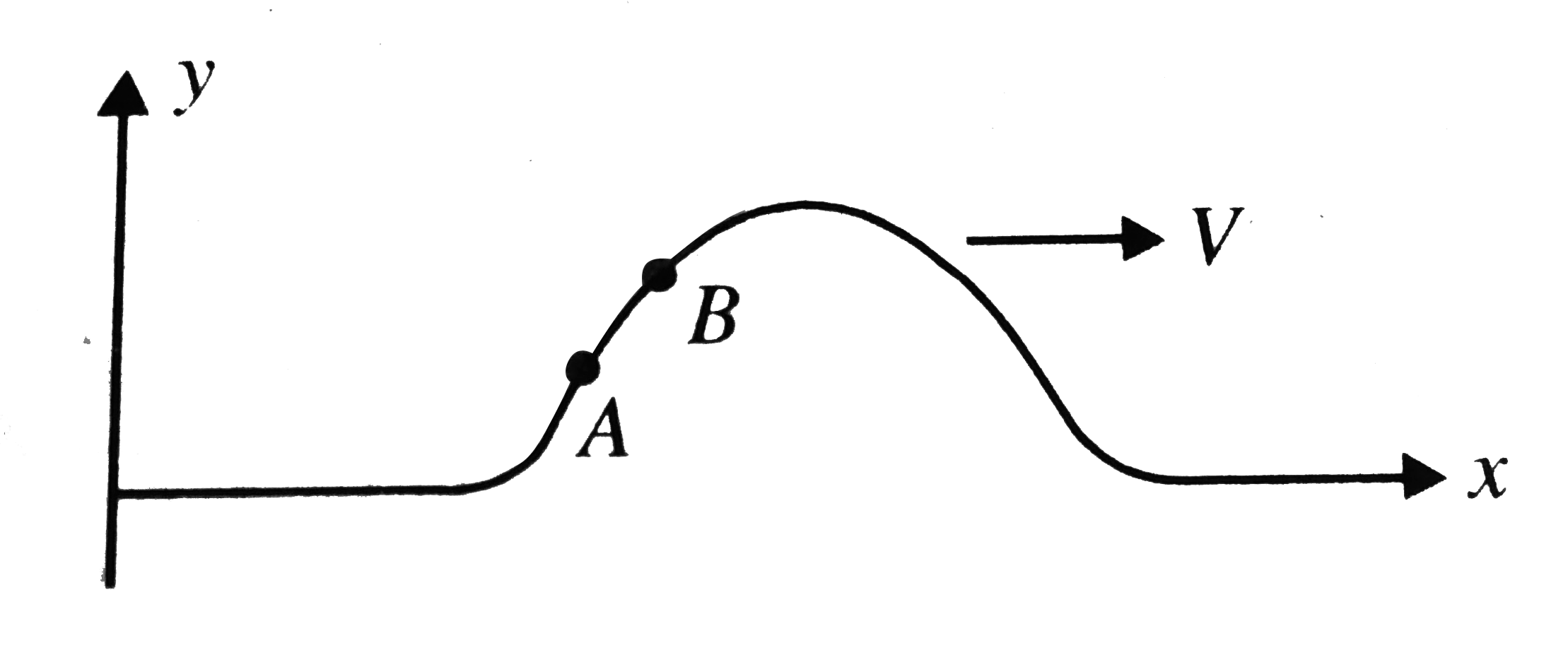 01:53View Solution
01:53View SolutionSinusoidal waves `5.00 cm ` in amplitude are to be transmitted along a string having a linear mass density equal to `4.00xx10^-2kg//m`. If the source can deliver a maximum power of `90W` and the string is under a tension of `100N`, then the highest frequency at which the source can operate is (take `pi^2=10`)
02:28View SolutionAdjoining figure shows the snapshot of two waves A and B at any time t. the equation for A is `y=Asin (kx-omegat-phi)`, and for B it is `y=A sin (kx-omega t)`. It is clearly shown in the figure that wave A is ahead of B by a distance `phi//k`.
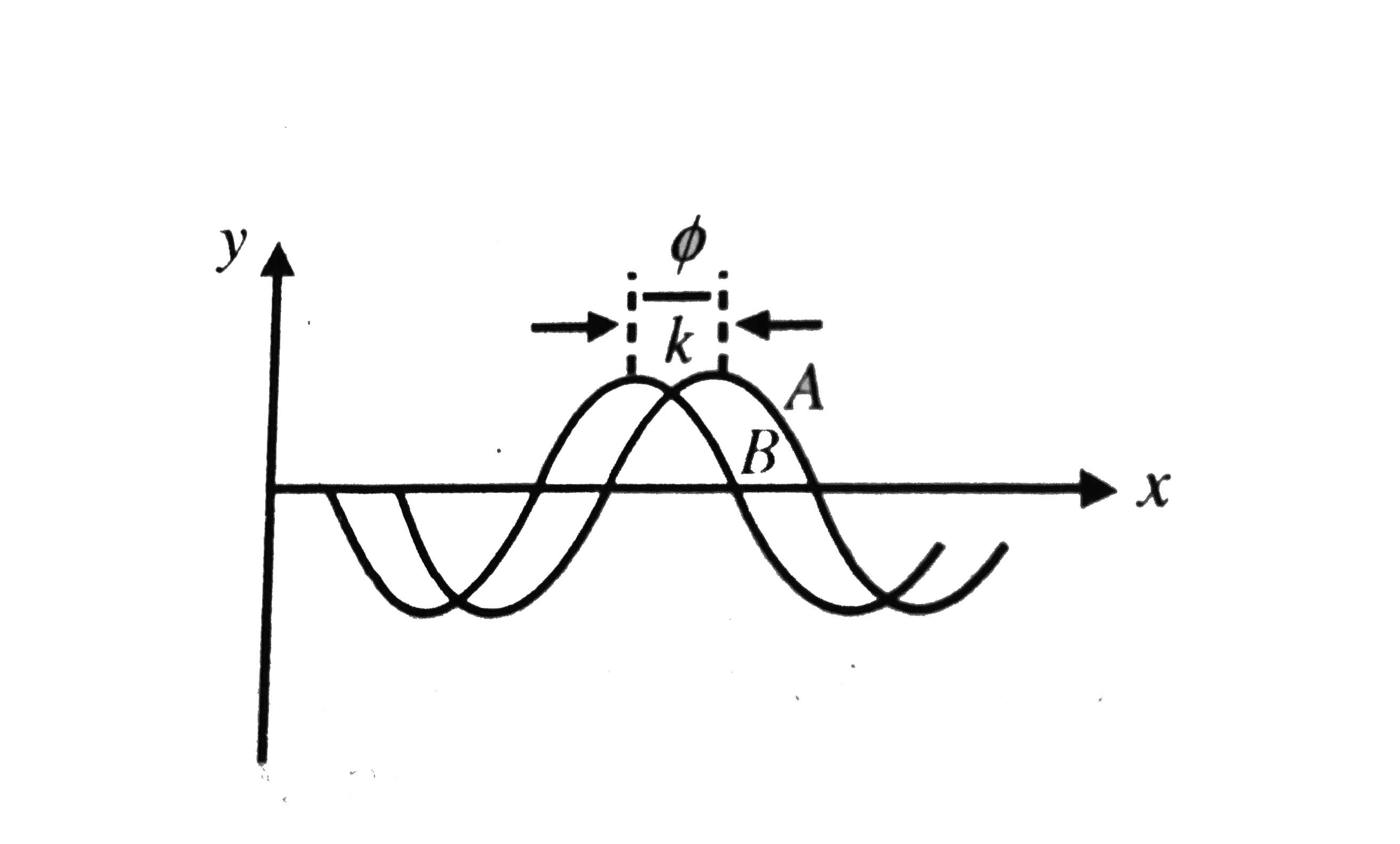 02:26View Solution
02:26View SolutionA transverse sinusoidal wave is generated at one end of a long horizontal string by a bar that moves the end up and down through a distance by `2.0 cm`. the motion of bar is continuous and is repeated regularly `125` times per second. If klthe distance between adjacent wave crests is observed to be `15.6 cm` and the wave is moving along positive `x-`direction, and at `t=0` the element of the string at `x=0` is at mean position `y =0` and is moving downward, the equation of the wave is best described by
05:00View SolutionIf the maximum speed of a particle on a travelling wave is `v_(0)`, then find the speed of a particle when the displacement is half of the maximum value.
02:35View SolutionA sinusoidal wave is genrated by moving the end of a string up and down, periodically. The genrated must apply the energy has ………..x and least power when the end of the string attached to genrated to genrated has ………..Y. the most suitable option which correctly fills blanks X and Y, is
03:15View SolutionA point source of sound is placed in a non-absorbing medium two points A and B are at the distance of 1 m and 2 m, respectively, from the source. The ratio of amplitudes of waves at A to B is
01:42View SolutionTwo canoes are `10 m` apart on a lake . Each bobs up and down with a period of `4.0 s`. When one canoe is at its highest point , the other canoe is at its lowest point . Both canoes are always within a single cycle of the waves . The canoes are always within a single cycle of the waves . The speed of wave is .
01:42View SolutionThe mathmaticaly form of three travelling waves are given by
`Y_(1)=(2 cm) sin (3x-6t)`
`Y_(2)=(3 cm) sin (4x-12t)`
And `Y_(3)=94 cm) sin(5x-11t)`
of these waves,02:55View SolutionA transverse wave on a string travelling along + ve x-axis has been shown in the figure below:
The mathmetical form of the shown wave is
`y=(3.0 cm) sin [2pixx0.1t-(2pi)/(100)x]`
where t is in seconds and x is in centimetres. Find the total distance travelled by the particle at (1) in 10 min 15 s. measured from the instant shown in the figure and direction of its motion at the end of this time.
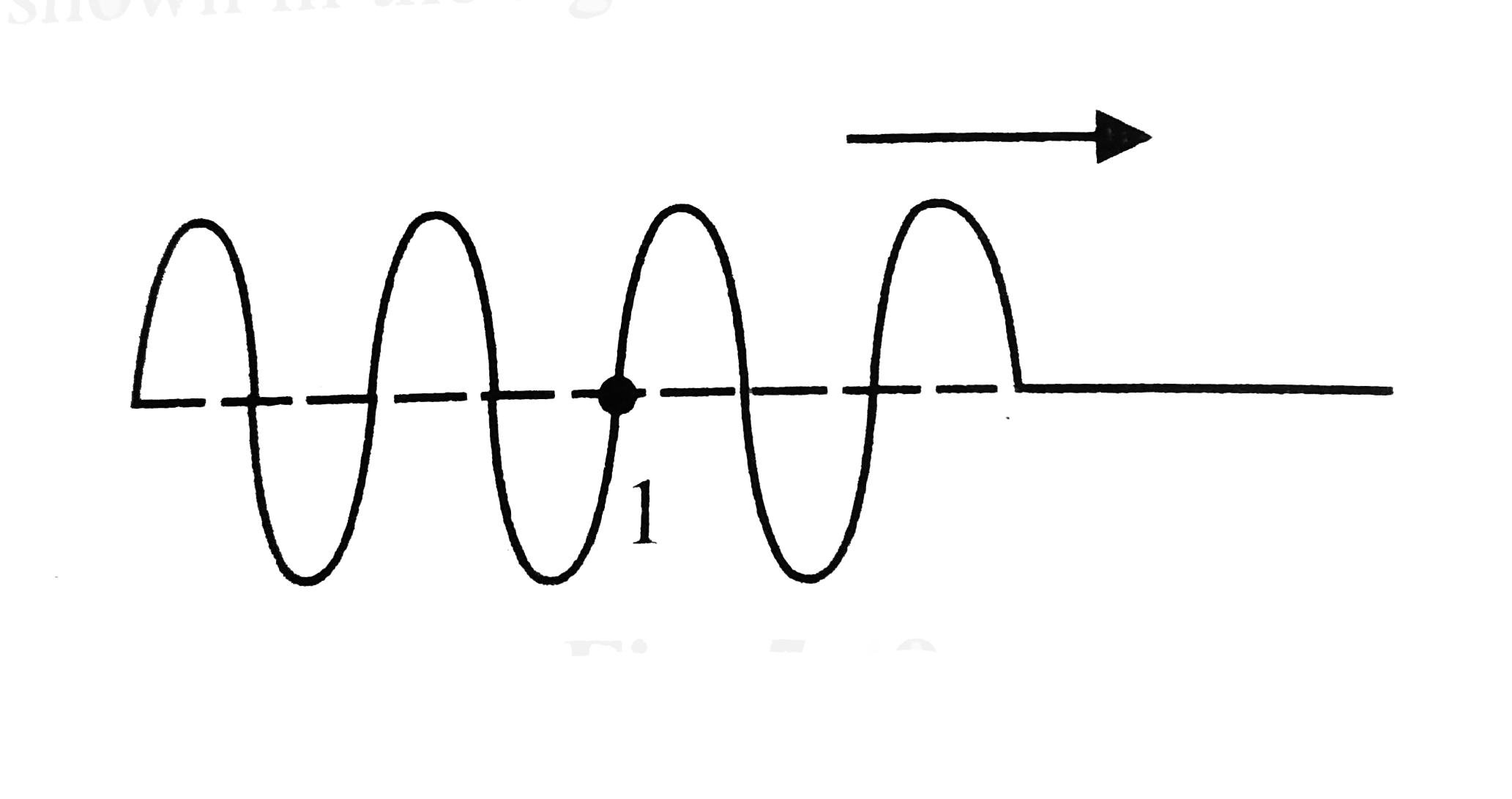 03:45View Solution
03:45View SolutionA water surface is moving at a speed of `15 m//s`. When he is surfing in the direction of wave, he swing upwards every 0.8 s because of wave crests. While surfing in opposite direction to that of wave motion, he swings upwards every 0.6 s. determine the wavelength of transverse component of the water wave.
03:31View SolutionA transverse wave on a string has an amplitude of 0.2 m and a frequency of 175 Hz. Consider a particle of the string at x=0. it begins with a displacement y=0, at t=0, according to equation `y=0.2 sin (kx+-omegat)`. How much time passed between the first two instant when this particle has a displacement of y=0.1 m?
02:58View SolutionIf a wave is going from one medium to another, then
01:24View SolutionAt t=0,a transverse wave pulse travelling in the positive x direction with a speed of `2 m//s` in a wire is described by the function `y=6//x^(2)` given that `x!=0`. Transverse velocity of a particle at x=2 m and t= 2 s is
02:31View SolutionA harmonic wave has been set up on a very long string which travels along the length of string. The wave has frequency of 50 Hz. Amplitude 1 cm and wavelength 0.5 m. for the above described wave.
Statement (i): time taken by a point on the string to travel a distance of 8 m along the length of string is 0.32 s.
Statement (ii): time taken by a point in the string to travel a distance of 8m, once the wave has reached at that point and sets it into motion is 0.32 s.04:18View SolutionA point source of sound is placed in a non-absorbing medium two points A and B are at the distance of 1 m and 2 m, respectively, from the source. The ratio of amplitudes of waves at A to B is
01:43View SolutionA wave is represented by the equation
`y = A sin (10 pi x + 15 pi t + pi//3)`
Where x is in metre and t is in second.
a wave travelling in the positive x-direction with a velocity of 1.5 m/s
a wave travelling in the negative x-direction with a velocity 1.5 m/s
a wave travelling in the negative x-direction with a wavelength of 0.2 m
a wave travelling in the positive x-direction with a wavelength 0.2 m05:26View SolutionA progressive wave is given by
`y=3 sin 2pi [(t//0.04)-(x//0.01)]`
where x, y are in cm and t in s. the frequency of wave and maximum accelration will be:03:42View SolutionA transverse waves is travelling in a string. Study following statement.
(i) Equation of the wave is equal to the shape of the string at an instant t. (ii) Equation of thhe wave is general equation for displacement of a particle of the string (iii) Equation of the wave must be sinusoidal equation (iv) Equation of the wave is an equation for displacement of the particle at one end only.correct statement are04:44View SolutionThe equuation of a wave is given by
`y=0.5 sin (100 t+25x)`
The ratio of maximum particle velolcity to wave velocity is:02:34View SolutionThe phase difference between two waves.
`y_(1)= 10^(-6) sin{100 t + (x/50)+ 0.5}m`
`y_(2)= 10^(-6) sin{100 t + (x/50)}m`
where, x is expressed in metre and t is expressed in second , is approximately02:30View SolutionWhich of the following is not true for the progressive wave
`y=4sin2pi((t)/(0.02)-(x)/(100))`
where x and y are in cm and t in seconds.02:26View SolutionThe amplitude of a wave disturbance propagating along positive X-axis is given by `=1/(1+x^(2))` at t=0 and `y=1/[1+(x-2)^(2)]` at t=4 s where x and y are in metre. The shape of wave diturbance does not change with time. The velocity of the wave is
02:59View SolutionConsider a wave rpresented by `y= a cos^(2) (omega t-kx)` where symbols have their usual meanings. This wave has
03:56View SolutionAt t=0, a transverse wave pulse in a wire is described by the function `y=6//(x^(2)-3)` where x and y are in metres. The function y(x,t) that describes this wave equation if it is travelling in the positive x direction with a speed of `4.5 m//s` is
02:41View SolutionA stretched rope having linear mass density `5xx10^(-2)kg//m` is under a tension of `80 N`. the power that has to be supoplied to the rope to generate harmonic waves at a frequency of `60 Hz` and an amplitude of `(2sqrt2)/(15pi)m` is
03:34View SolutionA string of length 2L, obeying hooke's law, is stretched so that its extension is L. the speed of the transverse wave travelling on the string is v. If the string is further stretched so that the extension in the string becomes 4L. The speed of transverse wave travelling on the string will be
03:54View SolutionA sinusoidal wave trsvelling in the positive direction on a stretched string has amplitude `2.0 cm`, wavelength `1.0 m` and velocity `5.0 m//s`. At `x = 0` and ` t= 0` it is given that `y = 0` and `(dely)/(delt) lt 0`. Find the wave function `y (x, t)`.
04:53View SolutionFor the wave shown in figure, write the equation of this wave if its position is shown at `t= 0`. Speed of wave is `v = 300m//s`.
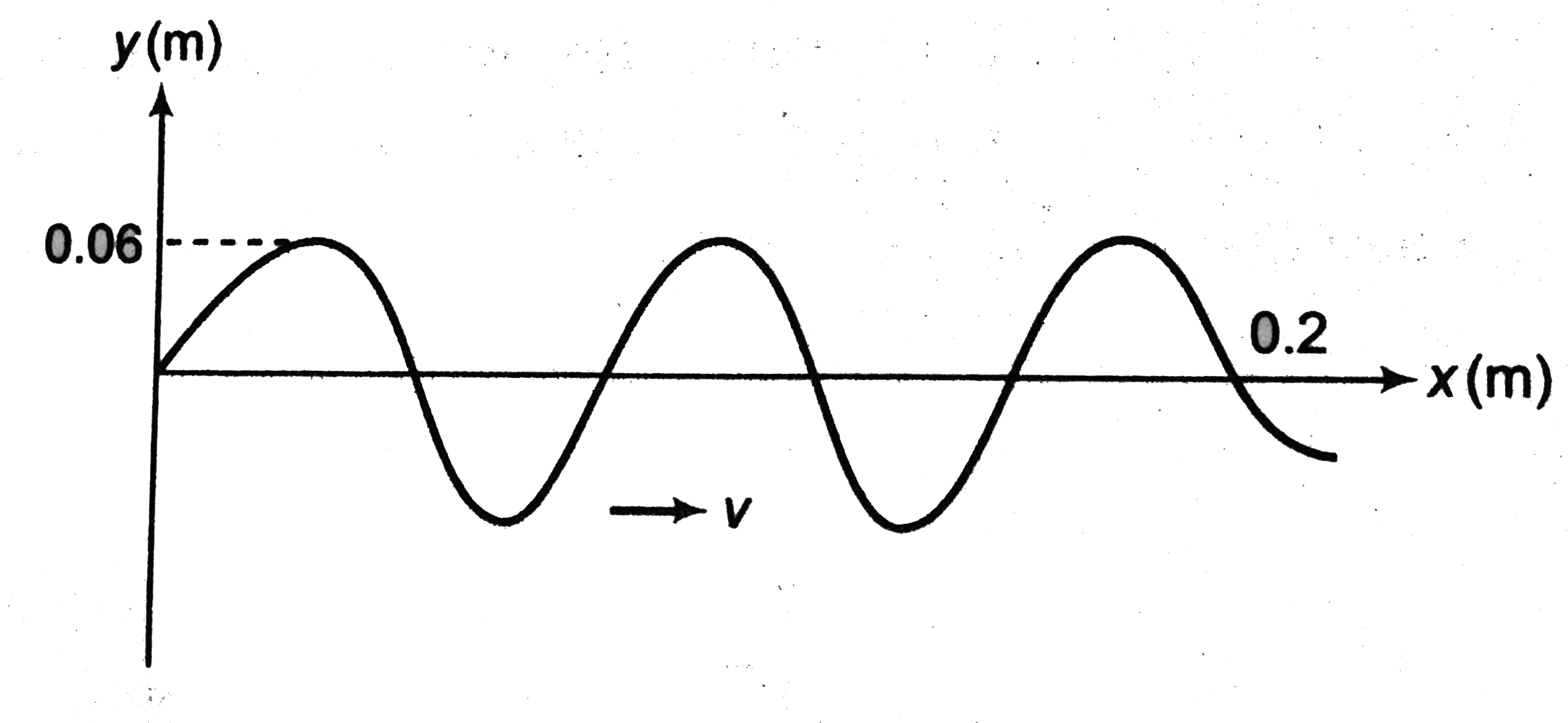 08:20View Solution
08:20View Solution
A wave motion has the function `y=a_0sin(omegat-kx)`. The graph in figure shows how the displacement y at a fixed point varies with time t. Which one of the labelled points Shows a displacement equal to that at the position `x=(pi)/(2k)` at time `t=0`?02:08View SolutionThe prong of an electrically operated tuning fork is connected to a long string of `mu=1 kg//m` and tension 25 N, the maximum velocity of the prong is `1 cm//s`, then the average power needed to drive the prong is
 02:08View Solution
02:08View SolutionThe figure below is a representation of a simple harmonic progressive in the negative X-axis, at a given instant. The direction of the velocity of the particle at stage P in the figure is best represent by the arrow.
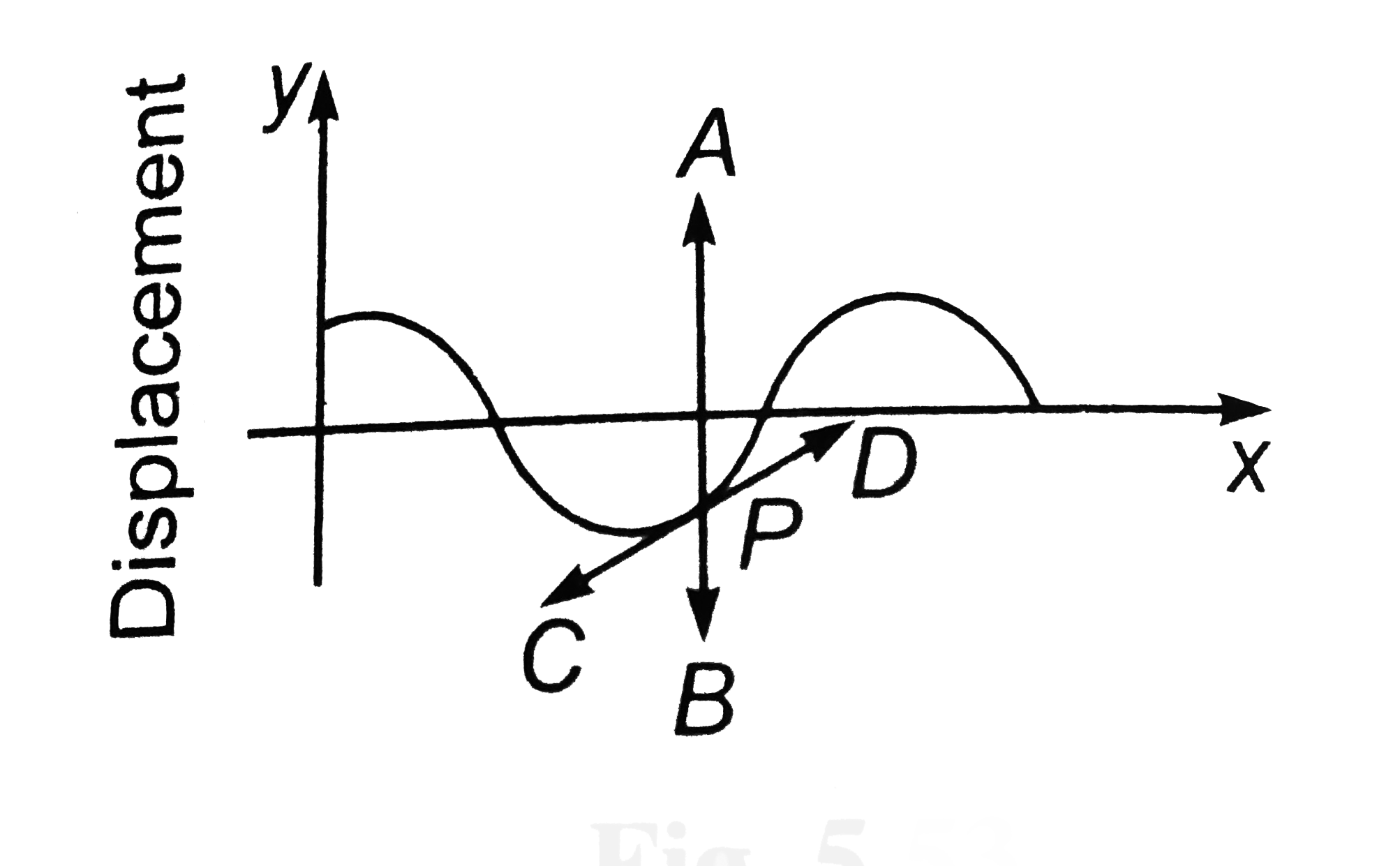 01:07View Solution
01:07View SolutionThe graph shows a wave at t=0 travelling to the right with a velocity of `4 m//s`. The equation that best represents the wave is
 02:41View Solution
02:41View SolutionA circular loop of rope of length L rotates with uniform angular velocity `omega` about an axis through its centre on a horizontal smooth platform. Velocity of pulse (with resppect to rope ) produce due to slight radiul displacement is given by
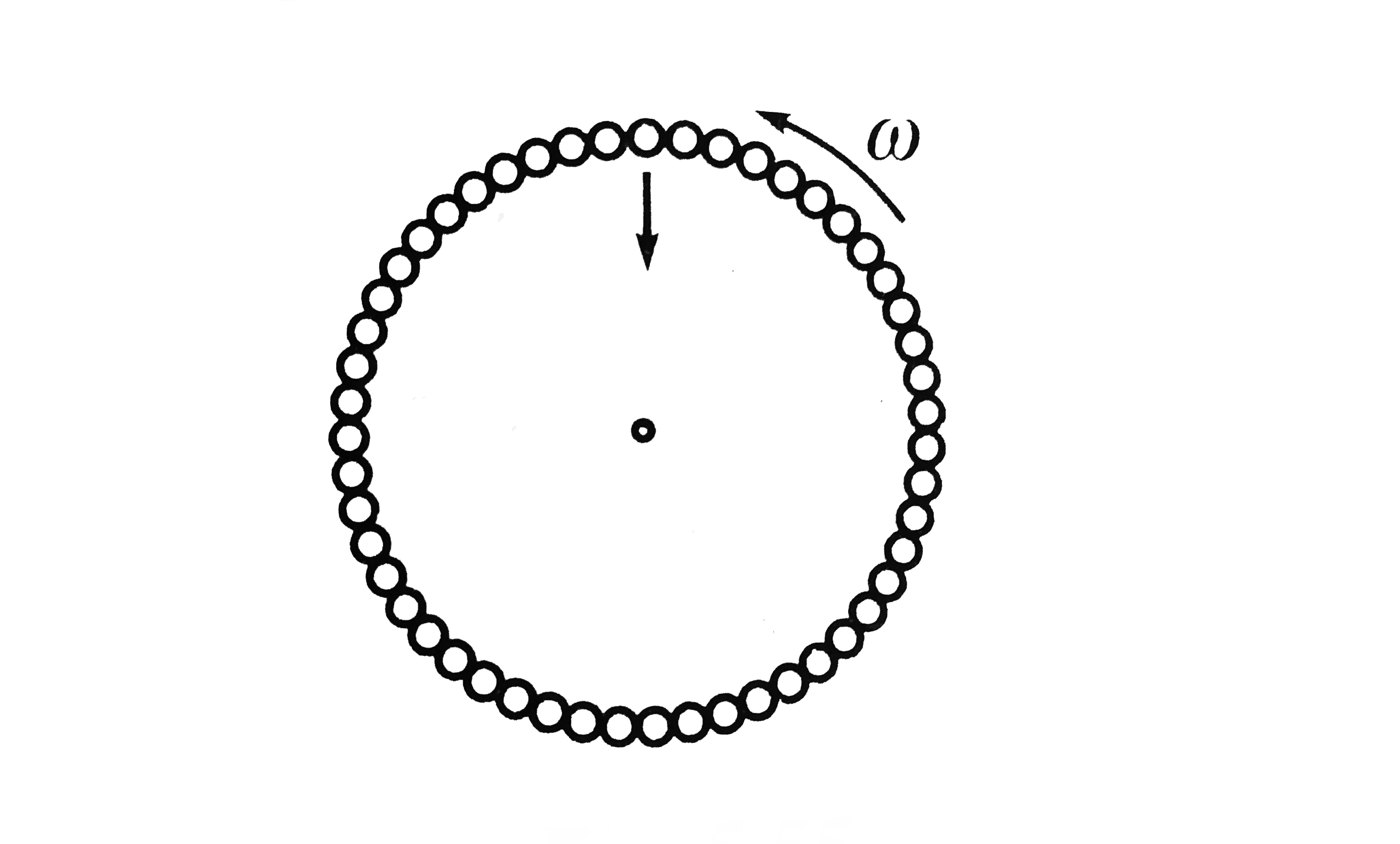 03:21View Solution
03:21View SolutionIn the above question, if equal forces are applied on two springs, then
03:39View SolutionIn the above question,if both are in opposite direction. Then the velocity of the pulse w.r.t. to groun will be:
01:19View SolutionGraph shows three waves that are separately sent along a string that is stretched under a certain tension along x-axis. If `omega_(1),omega_(2) and omega_(3)` are their angular frequencies, respectively, then:
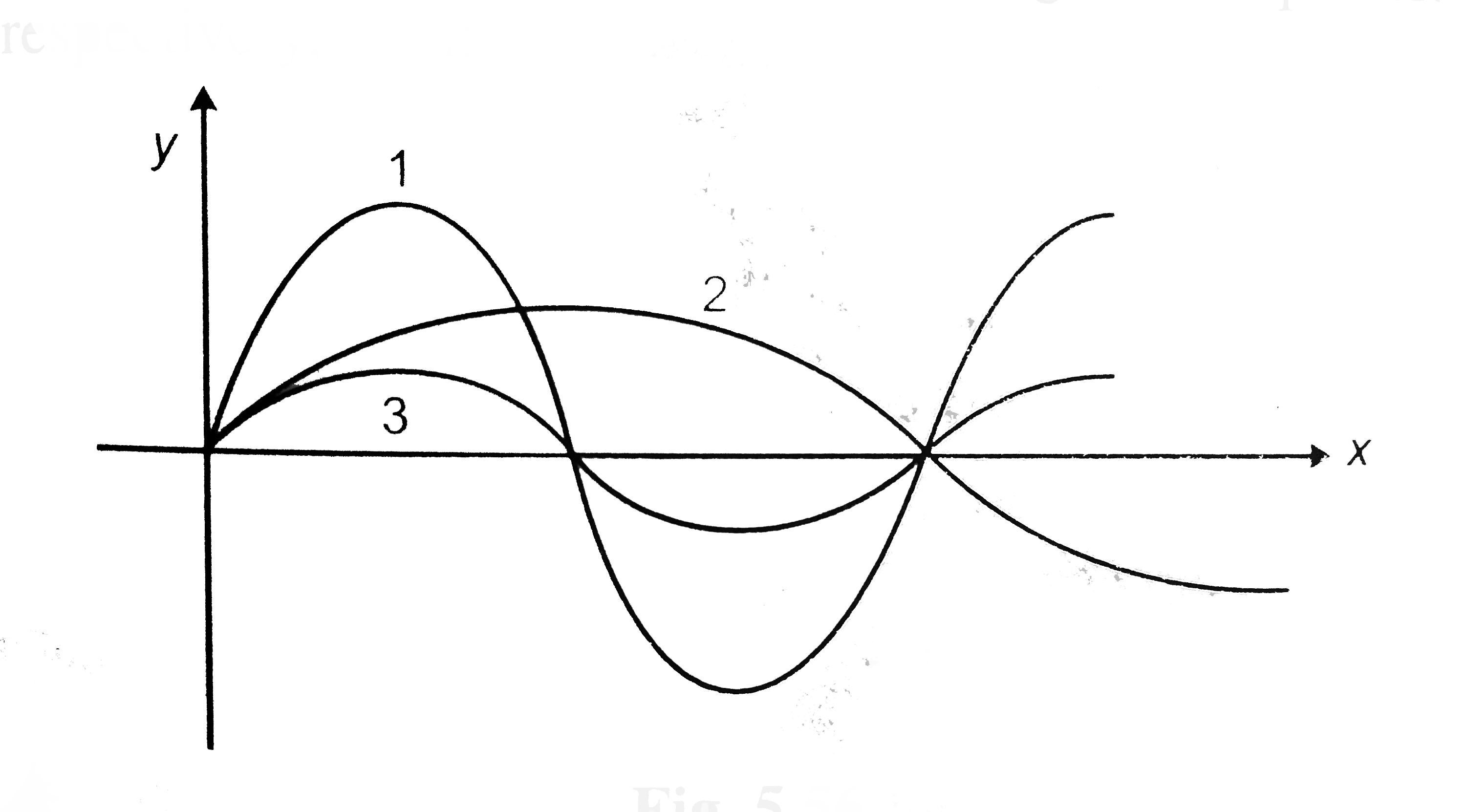 02:38View Solution
02:38View SolutionA certain transverse sinusoidal wave of wavelength 20 cm is moving in the positive x direction. The transverse velocity of the particle at x=0 as a function of time is shown. The amplitude of the motion is:
 02:56View Solution
02:56View Solution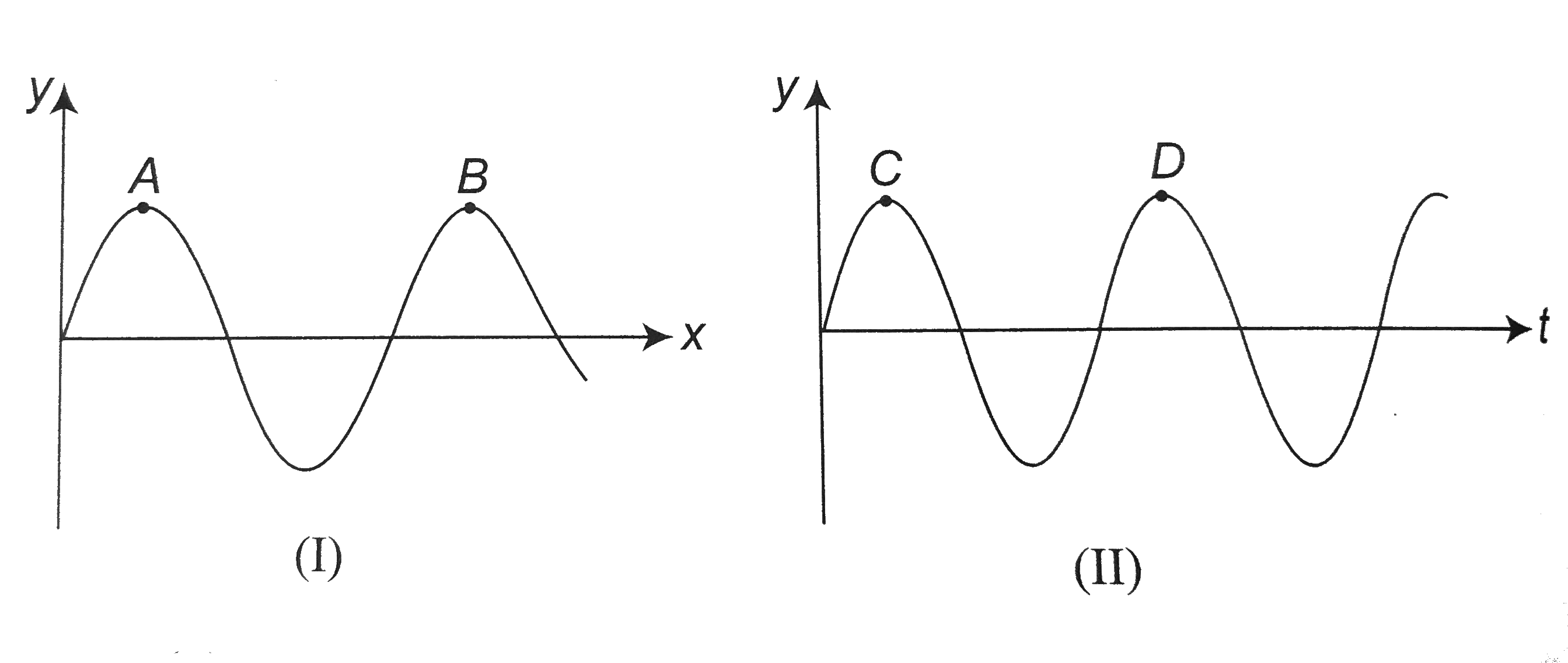
The same progressive wave is represented by two graphs I and II. Graph I shows how the displacement `y` varies with the distance x along the wave at a given time. Graph II shows how y varies with time t at a given point on the wave. The ratio of measurements AB to CD, marked on the curves represents:02:29View Solution
Single Correct questions and complete solutions for chapter TRAVELLING WAVES of CENGAGE PHYSICS (ENGLISH) of Class 11
